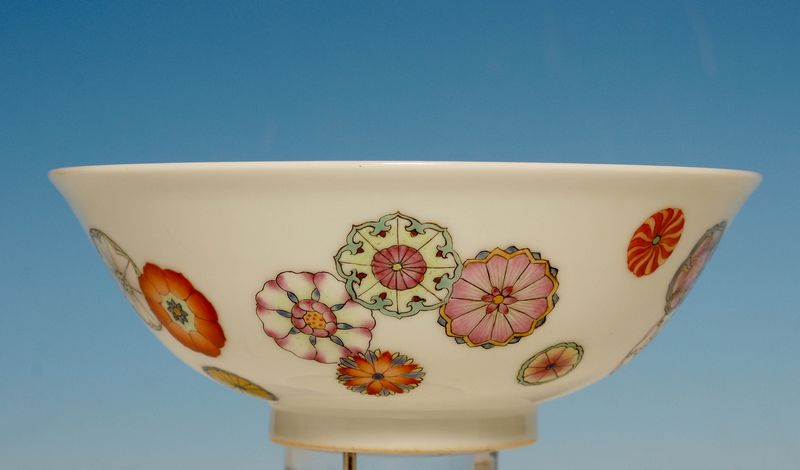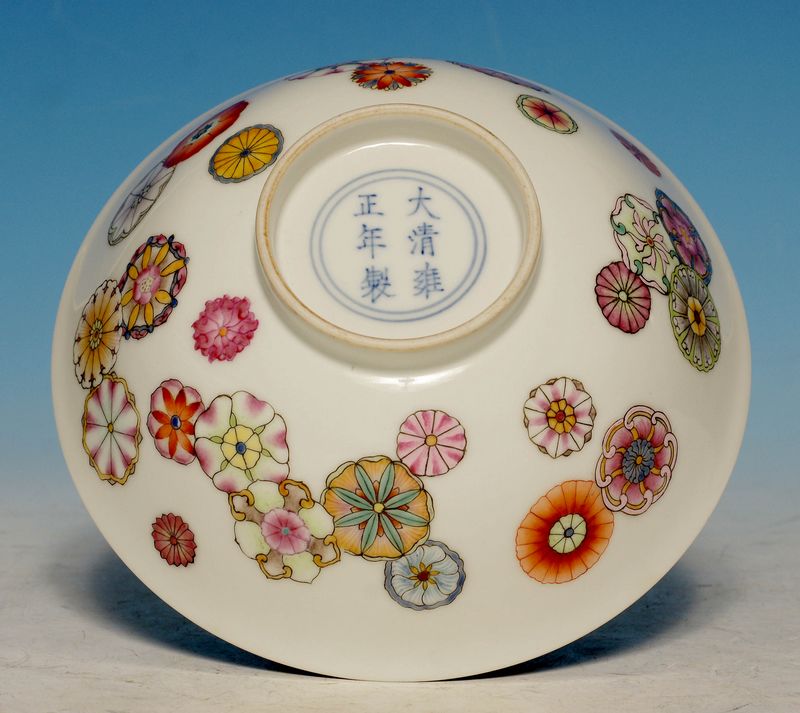苏富比香港

清雍正
粉彩皮球花盌 AN
EXCEPTIONALLYFINE AND RARE FAMILLE-ROSE FLOWER-BALLS BOWL
15.4
公分,6 1/8 英寸
此皮球花纹盌,图案属景德镇御窑厂创新之作,雍正一朝,皇帝勇于超越传统,力求突破,推陈出新。其父康熙帝复兴御窑,鼓励烧瓷技艺发展,四子雍正帝,则为御瓷之器形纹饰注入新生命。此举并没有把御瓷之风格嬗变与其传统割裂,反之,在圣上的鼓励下,宫廷画家与艺匠从丰沛源远的工艺发展中汲取精华,却未拘泥于传统规范,敢于破格求新,接受舶来饰样,古今兼备。
皮球团花,层迭相蔽。此图纹可溯源至日本,原乃家族徽章,呈圆形,称作「纹」,常见于织品、漆器、陶瓷及其他工艺品。虽说景德镇御瓷厂绘施团花纹,很可能与雍正帝对日本艺术之喜爱有关,然而在约一个世纪前明末之时,景德镇已有采用相似纹饰。为了对日外销,早于十七世纪中叶,景德镇的中国瓷匠已开始绘饰日式图案。许多青花及彩瓷(祥瑞及赤絵)均以相类团纹融入设计,或以此作边饰,迎合东瀛品味,例可见西田宏子及出川哲朗,《中国の陶磁》,卷10:明末清初の民窑,东京,1997年,图版32、64、66及页125,图75,页127,图81,页131,图89。
众知雍正帝推崇日本美学,对于日式金银莳绘漆艺更深感兴趣。清宫旧藏此类日本漆盒甚多,其中部分现藏台北故宫博物院,参见展览图录《清宫莳绘-院藏日本漆器特展》,台北,2002年,其中提到(页10):「清代的雍正皇帝由于喜爱莳绘,时常命造办处仿作洋漆,不过在制作时,常依喜好修改样式。另一方面,雍正也常移植洋漆的装饰风格或纹样。」
此盌上所饰,常称为「皮球花」,似借鉴日本莳绘图样,如台北故宫藏多件日本漆盒,皆饰此团花纹样(同上注,图版20、32、61、65、68-71),可以推想雍正帝曾鼓励清宫画师,自东洋器物撷取灵感,进而发展出御瓷上之中式图纹。景德镇御窑厂,曾以鬪彩及粉彩描绘皮球花纹,后者以新研发之不透明粉彩调子,细绘团花,清新悦目。
北京故宫藏相近瓷盌,收录于《故宫博物院藏文物珍品全集.珐琅彩.粉彩》,香港,1999年,图版67。Keith
Murdoch 爵士及 Andrew Drummond
递藏一对,1995年5月1日在香港佳士得拍出,编号669,现为望星楼宝蓄,收入《清代康雍干官窑瓷器:望星楼藏瓷》,明尼阿波利斯艺术学院,明尼阿波利斯,2002年,编号49。台北故宫博物院藏一雍正年款盌,尺寸略小,见于该院展览《雍正-清世宗文物大展》,台北,2009年,编号II-88。玫茵堂旧藏一对鬪彩皮球花杯例,售于香港苏富比2011年4月7日,编号6。另有两杯,分别以鬪彩及青花饰之,刊于《清宫瓷器:南京博物馆珍藏系列》,上海,1998年,图版25。
乾隆时,类似皮球花纹,见有不同组合变化,有饰于较奢华之锦地或单色釉瓷上。作例可见北京故宫博物院藏茶壶二把,皆出自清宫旧藏,刊录于《故宫博物院藏文物珍品全集.珐琅彩.粉彩》,前述出处,图版108、109。
来源 : Gordon Cummings
承产收藏纽约佳士得1987年12月10日,编号275香港苏富比1990年11月13日,编号299香港佳士得2000年10月31日,编号912[********]
出版 :
《香港苏富比二十周年》,香港,1993年,图版284[********]
elegantly potted with rounded sides rising from a short foot to a
flared rim, finely decorated around the exterior with a profusion
of multi-coloured flower-balls arranged asymmetrically and
scattered throughout, some freely floating, others overlapping in
small clusters of two or three blooms, all carefully enamelled in
soft pastels against a white ground, the base inscribed in
underglaze blue with a six-character mark within a double circle,
wood stand15.4 cm, 6 1/8 in.
Exquisitely painted with a stylised floral design that belongs to
one of the most daring and progressive designs ever devised at the
Jingdezhen imperial kilns, the development of this motif can be
credited to the Yongzheng Emperor’s bold initiative to go beyond
tradition and to build upon the long-established framework of
Chinese patterns to create new styles. The newly revived and
invigorated kilns set up by his father, the Kangxi Emperor, opened
the doors for the Yongzheng Emperor to breathe new life into the
craftsmen’s repertoire. Court artisans were directed to look to
China’s rich history of celebrated arts and crafts as well as to
foreign styles of decoration to produce pieces that were at once
familiar and innovative. The pattern of overlapping roundels
appears to have its origins in Japanese design, where circular
heraldic family symbols (mon) are a popular motif for adorning
textiles, lacquer, ceramics and other works of art. Although the
adoption of this design by the Qing imperial kilns is very likely
due to the Yongzheng Emperor’s interest in Japanese aesthetics,
a similar design had already been used in Jingdezhen almost a
century earlier in the late Ming dynasty. Chinese potters at
Jingdezhen began to use Japanese designs in the mid-17th century,
at a time when items were created in the Japanese taste for export
to Japan. Many of the blue and white and polychrome porcelains
made for the Japanese market (shonzui and aka-e) have these
roundels incorporated into the design or used as a border; see
Nishida Hiroko and Degawa Tetsuro, Chugoku no toji/Chinese
Ceramics, vol. 10, Min Matsu Shin so no minyo/Export Porcelain in
the Late Ming to Early Qing, Tokyo, 1998, pls 32, 64, 66, and p.
125, fig. 75, p. 127, fig. 81, and p. 131, fig. 89. Of particular
interest to the Yongzheng Emperor was the Japanese art of lacquer
that incorporated gold and silver (makie). Many Japanese lacquer
boxes with such designs were in the court collection, of which
some are preserved in the National Palace Museum, Taipei, and
included in the Museum’s exhibition Qing gong makie. Yuan cang
Riben qiqi tezhan [Gold and silver lacquer work in the Qing
Palace. Special exhibition of Japanese lacquer wares held by the
Museum], 2002. The catalogue to the exhibition notes that
"the appreciation and admiration that the Yung-Cheng emperor
held for Japanese lacquerware was so great that he not only
encouraged their production in the imperial factories but also
promoted the implementation of lacquerware styles and designs on
other mediums" (p. 20). The present design, often called the
‘flower-ball’ pattern (piqiu hua) appears to stem from such
Japanese lacquer designs. Many of the Japanese lacquer boxes in
the National Palace Museum depict related roundels (e.g. ibid.,
cat. nos 20, 32, 61, 65, 68-71), which suggest that the Emperor
encouraged court artists to develop them into completely Chinese
designs on imperial porcelain. This motif was produced in both
doucai and famille rose palettes, the latter version providing a
particularly enchanting and fresh aesthetic as it accentuates the
newly developed palette against the silky white porcelain. A
closely related bowl, in the Palace Museum, Beijing, is published
in The Complete Collection of Treasures of the Palace Museum.
Porcelains with Cloisonne Enamel Decoration and Famille Rose
Decoration, Hong Kong, 1999, pl. 67; and a pair, from the
collections of Sir Keith Murdoch and Andrew Drummond, was sold at
Christie’s Hong Kong, 1st May 1995, lot 669, now in the Wang
Xing Lou collection, included in the exhibition Imperial
Perfection. The Palace Porcelain of Three Chinese Emperors. A
Selection from the Wang Xing Lou Collection, Minneapolis Institute
of Arts, Minneapolis, 2002, cat. no. 49. Compare a smaller
Yongzheng mark and period bowl, in the National Palace Museum,
Taipei, included in the Museum’s exhibition Harmony and
Integrity. The Yongzheng Emperor and His Times, 2009, cat. no.
II-88. See also a pair of Yongzheng doucai cups decorated with
this design, from the Meiyintang collection, sold in these rooms,
7th April 2011, lot 6; and two cups, one painted in doucai and the
other in underglaze blue only, published in Qing gong ciqi.
Nanjing bowuguan zhencang xilie/Imperial Kiln Porcelain of Qing
Dynasty. Gems of Collections in Nanjing Museum, Shanghai, 1998,
pl. 25. This design was further developed in the succeeding
Qianlong reign, featuring on various vessels and in combination
with other decorative schemes; for example see two teapots with
coloured grounds, from the Qing court collection and still in
Beijing, illustrated in The Complete Collection of Treasures of
the Palace Museum. Porcelains with Cloisonne Enamel Decoration and
Famille Rose Decoration, op. cit., pls 108 and 109.
Provenance : The estate of Gordon Cummings.Christies New York,
10th December 1987, lot 275.Sothebys Hong Kong, 13th November
1990, lot 299.Christies Hong Kong, 31st October 2000, lot
912.[********] Literature : Sothebys Hong Kong: Twenty
Years, 1973-1993, Hong Kong, 1993, pl. 284.[********]
---------------------以下为翻译,仅供参考---------------------
优雅的盆栽,从短脚到圆形边缘,外部装饰精美,多种颜色的花球不对称排列,散落在一起,有些自由漂浮,其他重叠两个或三个花朵的小簇,全部用柔和的粉彩在白色地面上小心地珐琅,底部刻有釉下蓝色,在双圆圈内有六个字符的标记,木架15.4厘米,6
1/8英寸。
精美的花卉设计风格,属于景德镇皇家窑设计的最大胆和最先进的设计之一,这个主题的发展可以是归功于雍正皇帝大胆倡导超越传统,建立中国模式的长期框架,创造新风格。他的父亲康熙皇帝设立的新近复活的窑炉为雍正皇帝打开了大门,为工匠的保留节目注入了新的活力。法院工匠被指示着眼于中国丰富的着名艺术和手工艺品历史以及外国风格的装饰,以生产出既熟悉又富有创意的作品。重叠圆形图案似乎起源于日本设计,其中圆形纹章家族符号(mon)是装饰纺织品,漆器,陶瓷和其他艺术品的流行图案。虽然清代皇帝窑采用这种设计很可能是由于雍正皇帝对日本美学的兴趣,但近一个世纪以前的景德镇已经采用了类似的设计。中文景德镇的陶艺家在17世纪中期开始使用日本设计,当时日本出口的商品出口到日本。许多为日本市场制作的蓝色和白色和彩色瓷器(shonzui和aka-e)将这些圆形物装入设计中或用作边框;见Nishida
Hiroko和Degawa Tetsuro,Chugoku no toji / Chinese
Ceramics,vol。 10,Min Matsu Shin所以没有minyo
/出口瓷器在明末清初,东京,1998年,第32,64,66和p。
125,图。 75,p。 127,图。
81,和p。 131,图。 89.雍正皇帝特别感兴趣的是日本的漆器艺术,其中包括金银(makie)。许多具有这种设计的日本漆盒都在法院收藏中,其中一些被保存在台北国立故宫博物院,并被列入博物馆的清宫makie展览。元can
Rib Rib qi tezhan [清宫金银漆工作。日本特别展该博物馆举办的漆器,2002年。展览的目录指出,“荣成皇帝对日本漆器的赞赏和欣赏是如此之大,以至于他不仅鼓励他们在帝国工厂生产,而且还促进了在其他媒介上实施漆器样式和设计“(第20页)。目前的设计,通常被称为“花球”图案(piqiu
hua)似乎源于日本的漆器设计。国立故宫博物院的许多日本漆盒描绘了相关的圆形小册子(例如同上,第20,32,61,65,68-71页),这表明皇帝鼓励宫廷艺术家将它们发展成完全中国式的设计在皇家瓷器上。这个图案是用doucai和famille玫瑰色调制作而成的,后者版本提供了一种特别迷人和清新的美感,因为它突出了新开发的调色板与柔滑的白色瓷器。一个密切相关的碗,在宫殿北京博物馆出版于故宫珍宝全集。
Porcelains with Cloisonne Enamel Decoration and Famille Rose
Decoration,香港,1999,pl。
67;来自基思·默多克爵士和安德鲁·德拉蒙德的收藏品于1995年5月1日在佳士得香港拍卖,拍卖品669,现在在王兴楼收藏,包括在帝国完美展览中。中国三帝宫廷瓷器。
2002年明尼阿波利斯明尼阿波利斯艺术学院王兴楼收藏精选,猫。没有。
49.比较一下较小的雍正标志和时代碗,在台北国立故宫博物馆,包括在博物馆的和谐与诚信展览中。雍正皇帝和他的时代,2009年,猫。没有。
II-88。另见一对装饰有此设计的雍正斗彩杯,来自美音堂的收藏品,于2011年4月7日在这些房间内出售,拍品6号;出版了两个杯子,一个涂在斗菜上,另一个涂在釉下蓝色上在清宫ciqi。南京bowuguan
zhencang xilie /清代窑瓷。上海南京博物馆藏品宝石,1998,pl。
25.这一设计在后来的干隆年间得到进一步发展,以各种船只为特色,并与其他装饰方案相结合;例如,看到两个带有彩色地面的茶壶,来自清朝宫廷收藏品,还在北京,在故宫博物院藏品全集中有所体现。
Porcelains与景泰蓝珐琅装饰和Famille
Rose装饰,op。引用:Gordon
Cummings.Jristies纽约,1987年12月10日,地段275.Sothebys香港,1990年11月13日,地段299.Christies香港,2000年10月31日,地段912。
|

















